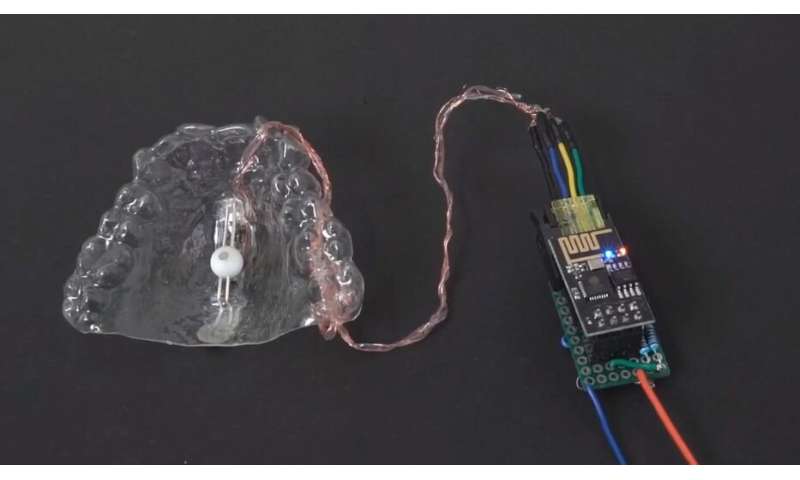
When someone refers to a people born into wealth and privilege, they might use the expression "born with a silver spoon in their mouth."
But will the day come when accomplished virtual reality game players are referred to as having been "born with an intraoral digital interface in their mouth"?
The expression may be a bit of a mouthful, but the notion is not so far-fetched. Graduate student Dorothee Clasen imagined constructing a tool that would allow users to bypass their hands or feet and control digital devices with their tongue. As part of her master's degree thesis at the Köln International School of Design, an institution of the Cologne University of Applied Sciences, Clasen came up with [In]Brace, a plastic retainer attached to a wireless transmitter.
The mouthpiece, customized to fit each user's mouth, contains a magnetic ball running along a sensor track that can be pushed or pulled by the tongue. A thin wire from the mouthpiece is connected to a wireless transmitter that is worn around an ear.
Clasen says the device can be used in situations where a user's hands are otherwise occupied. Such situations could include performers, pianists, for instance, who might employ the device to turn the pages of music sheets during a concert, or drummers using the latest generation of digital drum sets that generate different drum timbres and percussive effects to vary their sound mid-song. Motorists would be able to manipulate GPS routing alternatives without taking their hands off the wheel. And homeowners doing their routine Sunday lawn-mowing chores can place calls, listen to messages or select music without having to start and stop the mower each time.
There is also great potential for disabled users who will be exposed to productivity tools and games previously unavailable to them.
Clasen demonstrated [In]Brace with a takeoff of the classic game Pong, in this instance called "Tong." Although coordinating tongue-eye movement requires an orientation period, a user can quickly learn to manipulate the magnetic mouthpiece ball with about the same dexterity they would with hand controls.
The device recognizes "gestures" such as a quick flick of the tongue. Clasen hopes to broaden its capabilities by introducing haptic feedback in future versions.
Clasen, an experimental material and interaction designer, is a founder of the Integrated Interactions Laboratory in Cologne.
Along the same lines, last fall a graduate student from New Zealand offered a prototype "intraoral interface" in the shape of a lozenge. ChewIt is a wireless device the size of a breath mint that incorporates an accelerometer and gyroscope to track movement inside the mouth. Biting it replicates the push of a button, as does flipping it over with the tongue.
ChewIt creator Pablo Gallego Cascón, a graduate student in the Augmented Human Lab at the University of Auckland, said he sought to develop a mechanism that "doesn't draw the attention of others" and won't make the user "feel weird."
The main ChewIt drawback so far is the risk of swallowing it.
Explore further
© 2020 Science X Network
Citation: Oral device is a digital joystick (2020, July 30) retrieved 30 July 2020 from https://ift.tt/30btzVC
This document is subject to copyright. Apart from any fair dealing for the purpose of private study or research, no part may be reproduced without the written permission. The content is provided for information purposes only.
"device" - Google News
July 30, 2020 at 11:19PM
https://ift.tt/30btzVC
Oral device is a digital joystick - Tech Xplore
"device" - Google News
https://ift.tt/2KSbrrl
https://ift.tt/2YsSbsy
Bagikan Berita Ini














0 Response to "Oral device is a digital joystick - Tech Xplore"
Post a Comment